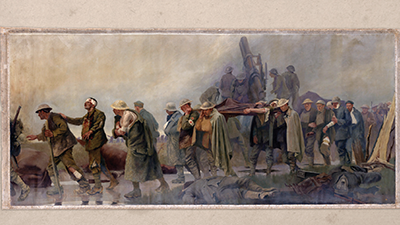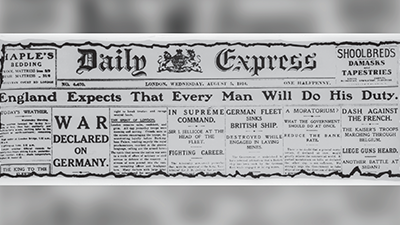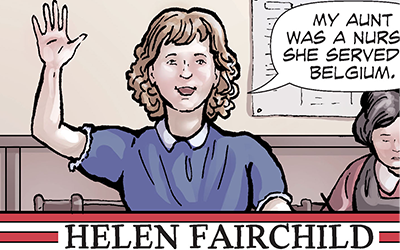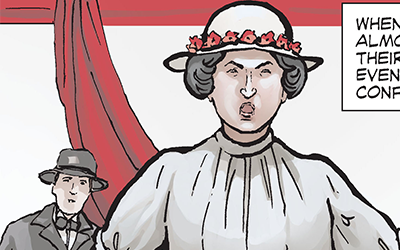The First Total War
Driving Question: How Was World War I different from previous conflicts?
World War I was more than a battlefield—it was a global experience. It blurred the line between home and front, and changed what war looked and felt like.
Learning Objectives:
- Create arguments using historical evidence to support claims and communicate conclusions through informal writing.
- Use evidence to understand key events and developments of World War I and evaluate how the conflict affected both soldiers and civilians.
- Compare two graphic biographies to support, extend, or challenge the overarching narratives of this period.
Opener: The First Total War
Engage with the complex causes of World War I, using course materials to support claims with evidence. This short writing activity will help prepare you to craft strong historical arguments.
Events of World War I
Understanding what happened during World War I is key to understanding its effects. Follow the key events of the First World War—where it was fought, how it escalated, and why it became one of history’s deadliest conflicts.
-
Guiding Questions
-
Before you read
Preview the questions below, and then skim the article. Be sure to look at the section headings and any images.
While you read
Look for answers to these questions:
- Why was planning and preparation so important in World War I?
- Why didn’t the Schlieffen Plan work?
- How did industrialization affect the fighting on the Western Front?
- Why did the Ottoman Empire and Italy join the war?
- What was the turning point that helped decide the war’s outcome?
After you read
Respond to this question: How did changes in political communities and production during the long nineteenth century shape the course of World War I?
What Is Total War?
Beyond the battlefields, World War I reached deep into people’s homes, jobs, and daily lives. These materials will help you understand what made this war “total” and why its impact was truly global.
-
Guiding Questions
-
Before you read
Preview the questions below, and then skim the article. Be sure to look at the section headings and any images.
While you read
Look for answers to these questions:
- What are four key features of total war?
- In what ways was World War I different from earlier wars?
- How did the war contribute to the spread of disease?
- How were wartime rules like the Hague Conventions violated?
- How did the war affect non-European societies beyond battlefield deaths?
After you read
Respond to these questions: What does it mean to say society was “totally controlled” during the war? Who had control, and who didn’t?
-
Guiding Questions
-
Before you watch
Preview the questions below, and then review the transcript.
While you watch
Look for answers to these questions:
- Why did Britain build such a large navy?
- What caused the arms race with Germany, and why did Britain win it?
- Who typically served in the Guards Regiments?
- How did Belgium’s situation lead Britain into war?
- Why is the poppy a symbol of World War I?
After you watch
Respond to this question: What do Britain’s production systems and war poetry show about the costs of total war?
The First World War transformed British society. Nick Dennis explores why Britain entered the conflict and how people in Britain experienced the war.
Key Ideas
Living in Total War
Comparing the lives of two very different women who lived during World War I will offer insight into the emotional and social toll of total war on individuals from different backgrounds.
-
Guiding Questions
-
Before you read
Preview the questions below, and then skim the comic, paying attention to things like prominent colors, shapes, and types of text and fonts. How do you know where to start and in which direction to read? What’s in the gutters (the space between panels)? Who or what is the focus of the comic?
While you read
- What did someone say about Helen Fairchild’s service in World War I?
- What work did Helen Fairchild do during the war?
- How did Helen Fairchild die?
- How is Helen Fairchild remembered today?
- How is the shape of the four central panels meaningful to this story?
After you read
Respond to this question: How does Helen Fairchild’s story add to your understanding of how people experienced and remembered World War I?
-
Guiding Questions
-
Before you read
Preview the questions below, and then skim the comic, paying attention to things like prominent colors, shapes, and types of text and fonts. How do you know where to start and in which direction to read? What’s in the gutters (the space between panels)? Who or what is the focus of the comic?
While you read
- Where was Rosa Luxemburg born?
- What were some of Rosa Luxemburg’s major accomplishments?
- How did Rosa Luxemburg feel about the First World War?
- How does the artist visually show Luxemburg’s emotions about the war?
- How is the shape formed by the central panel in the comic meaningful to the story?
After you read
Respond to these questions: How does Rosa Luxemburg’s opposition to the war compare to Helen Fairchild’s choice to serve? Whose decision do you relate to more?
Southeast Asia and the Middle East in World War I
Learn how World War I shaped regions far beyond Europe. Through two videos, you’ll examine how colonial powers mobilized people and resources in Southeast Asia and the Middle East, and how those regions responded to the pressures and promises of total war.
-
Guiding Questions
-
Before you watch
Preview the questions below, and then review the transcript.
While you watch
Look for answers to these questions:
- Who controlled most of Southeast Asia in 1914?
- How were people in Southeast Asia connected to events in the Middle East?
- Why did the Russo-Japanese War inspire people in Southeast Asia?
- What made Singapore strategically important?
- How did German submariners convince Indian soldiers to revolt in Singapore?
After you watch
Respond to this question: Was Southeast Asia important to the course of World War I? Use one of the course frames—communities, networks, or production and distribution—to support your answer.
The outcome of World War I wasn’t decided in Southeast Asia. But it was a world war, and it had significant impacts on the region.
Key Ideas
-
Guiding Questions
-
Before you watch
Preview the questions below, and then review the transcript.
While you watch
Look for answers to these questions:
- What political powers controlled the Middle East in 1914?
- Why did the Ottoman Empire issue a declaration of jihad during the war?
- Who was Sharif Hussein?
- What did the British promise Sharif Hussein during the war?
- What were mandates?
After you watch
Respond to this question: What was the most important way World War I changed the Middle East? Use the three maps from the video to support your answer.
The First World War helped lay the foundations for the modern Middle East. Imperialism, religion, and nationalism all played a role in shaping the region during this conflict.
Key Ideas
Technologies of World War I
These short videos reveal how new technologies transformed warfare during World War I. From gas masks to trench tools, you’ll learn how industrial innovations changed how wars were fought—and how soldiers survived.
-
Guiding Questions
-
Before you watch
Preview the questions below, and then review the transcript.
While you watch
Look for answers to these questions:
- What was the gas hood used for?
- How effective was the gas hood?
- Why didn’t the British expect Germany to use gas weapons?
After you watch
Respond to this question: How might poison gas and tools like the gas hood have changed how people thought about war?
Trench warfare in the First World War was horrific enough, but mustard gas really sent it over the top. In this short video, Andrew Wallis, of the Guards Museum in London, exhibits the shockingly inadequate gas hoods that British soldiers relied on to survive the horrors of chemical warfare.
-
Guiding Questions
-
Before you watch
Preview the questions below, and then review the transcript.
While you watch
Look for answers to these questions:
- What were knuckledusters and lead coshes?
- Why did soldiers carry close-combat weapons even if they had guns?
After you watch
Respond to this question: What does the way soldiers got these weapons tell us about the role of local communities during World War I?







